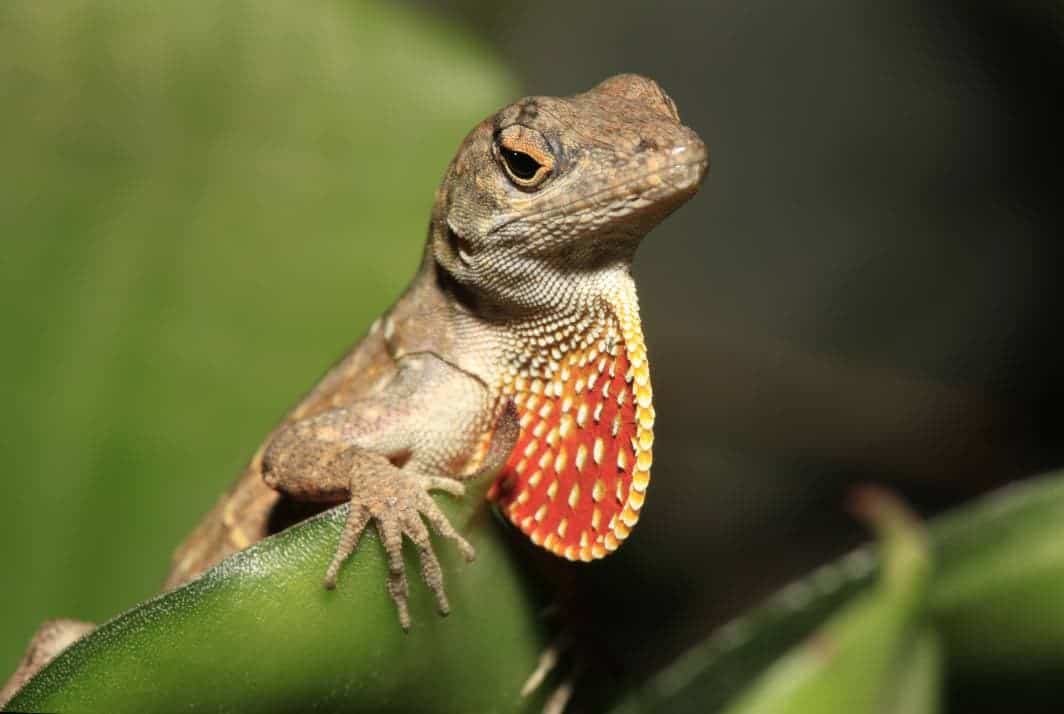Texas may be known for hot weather, barbeque, and live music, but it’s also home to many animal species. You may not think about lizards when you think of the Lone Star State, but several species of lizards do call Texas home. Both native and invasive lizards can be found wandering around Houston. City residents don’t need to worry, though. No species of lizards here are venomous or poisonous to people. Most aren’t even that big, so there’s no need to be concerned as they scurry around. Let’s take a look at Houston’s resident lizards and see what they’re all about.

The 8 Lizards Found in Houston
The 6 Native Houston Lizards
The following lizards are native to the United States or Texas specifically and can all be spotted in Houston. There are a few differences between them, but they’re also similar in many ways.
1. Five-Lined Skink
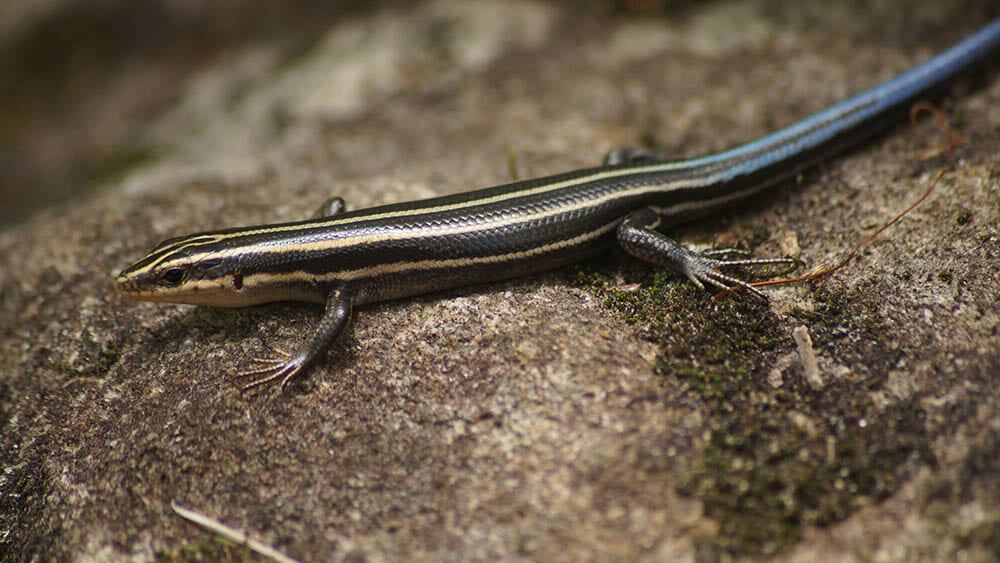
| Species: | P. fasciatus |
| Longevity: | 6 years |
| Good to own as a pet?: | Yes |
| Legal to own?: | Yes |
| Adult size: | 5 – 8.5 inches |
| Diet: | Insects, spiders, snails, and frogs |
The Five-Lined Skink loves the Houston climate for its moisture and humidity. They like to hide under trees and stumps and typically live on the ground, but you can find them in trees sometimes. They’re active during the day. They have dark brown or black bodies and as their name implies, five yellow stripes running lengthwise down their backs. As they age, these stripes fade. The tail is bright blue, and they can detach it when they’re in danger. The bright blue color distracts the predator while the lizard can escape. The tail will regenerate over time.
2. Texas Spiny Lizard
| Species: | S. olivaceus |
| Longevity: | 7 years |
| Good to own as a pet?: | Yes |
| Legal to own?: | Yes |
| Adult size: | 11 inches |
| Diet: | Beetles, wasps, grasshoppers, and other insects |
The Texas Spiny Lizards spend most of their time climbing or resting in trees. They scare easily, so if you hear leaves rustling on the ground around you, it could be this lizard shuffling away. Their noisiness comes from their side-to-side motion as they run. Their scales feel like little spines and are made of keratin, helping the lizard retain moisture and survive in hot, dry climates. Their bodies are grey with brown, white, or black spots down their backs. The color of the spots helps them blend in with their surroundings. Males have two long, blue patches on their sides.
3. Slender Glass Lizard

| Species: | O. attenuatus |
| Longevity: | 10+ years |
| Good to own as a pet?: | No |
| Legal to own?: | Yes |
| Adult size: | 22 – 42 inches |
| Diet: | Insects, small reptiles, and young rodents |
You might think that you’re looking at a snake, but this reptile is actually a lizard with no legs. Slender Glass Lizards have long dark stripes down their creamy yellow or light brown bodies. Unlike snakes, they have eyes that can open and close. You can find them in fields or sandy areas. Like most other lizards, the Slender Glass Lizards can break off their tails when captured or restrained. The tails will regrow, and it’s rare to find an adult with a tail that hasn’t been regenerated at some point. New tails won’t have the markings or length of the first one. They get the “glass” part of their name from the fact that they’re fragile and can be broken easily if handled improperly.
4. Broad-Headed Skink
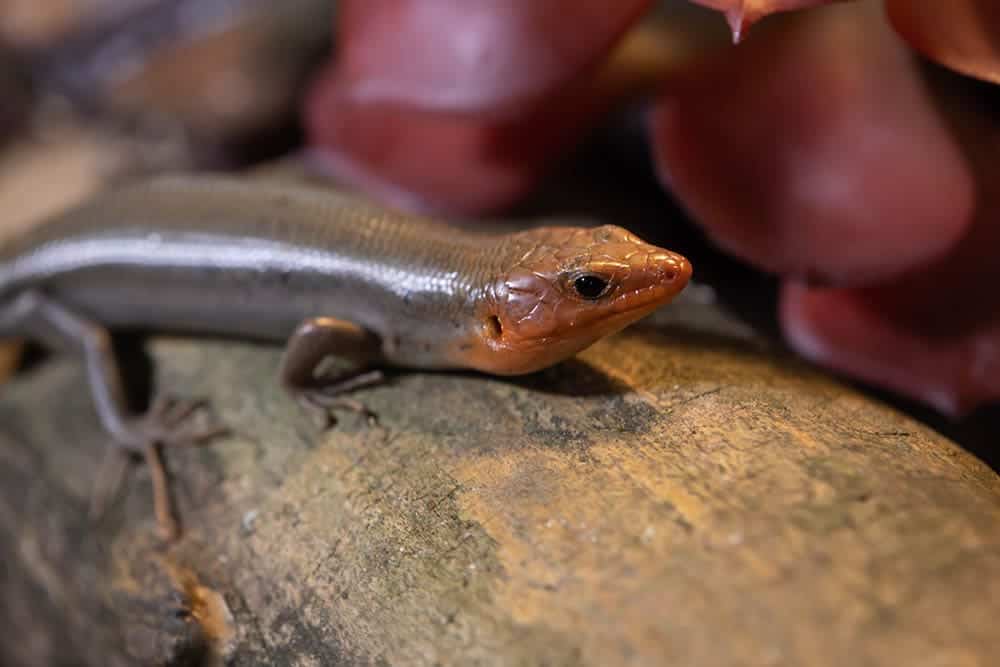
| Species: | P. laticeps |
| Longevity: | 4 – 8 years |
| Good to own as a pet?: | Yes |
| Legal to own?: | Yes |
| Adult size: | 6 – 13 inches |
| Diet: | Insects, mollusks, small reptiles, and rodents |
The Broad-Headed Skink can be confused with the Five-Lined Skink because the two look similar. Broad-Headed Skink babies have five cream or orange stripes down the length of their bodies with bright blue tails. As they age, they turn almost completely to an olive color, and the blue tails fade. Their heads turn orange in adulthood. The swollen jowls and heads of the males of this species give them their name. They live mostly in trees but hunt and eat on the ground. Included in the reptiles that these Skinks eat are the babies of their own species. Birds and larger reptiles eat these lizards, and they can also be eaten sometimes by mammals, including cats.
5. Little Brown Skink
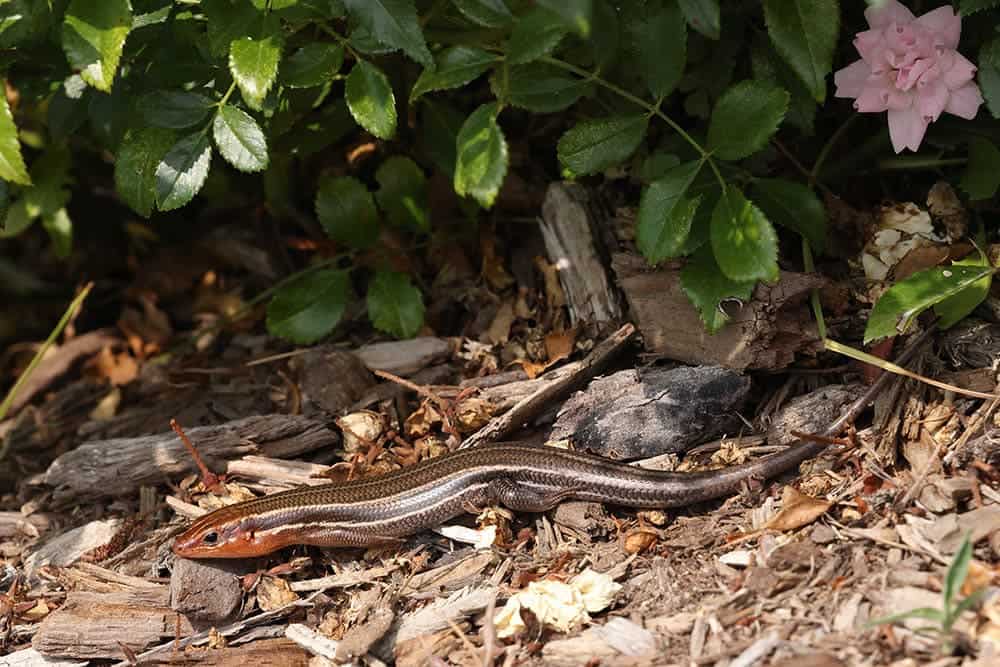
| Species: | S. lateralis |
| Longevity: | 2 – 4 years |
| Good to own as a pet?: | Yes |
| Legal to own?: | Yes |
| Adult size: | 3 – 5.75 inches |
| Diet: | Termites, millipedes, beetles, ants, and roaches |
You can find Little Brown Skinks in humid forests and along stream or pond edges. These lizards are ground-dwellers, preferring to live in decaying logs or loose soil. In colder months, they bury themselves in soil completely. In urban areas like Houston, you can find these Skinks along the sides of buildings or in empty lots. They have light, golden-colored backs and cream-colored bellies with smooth scales. These lizards look shiny. Their tails are light brown with a dark stripe, and like other lizards, they’ll shed this tail at the first sign of danger. Little Brown Skinks can also swim. Since they hang out by the water, they’ve been known to jump in it and swim away to escape predators.
6. Green Anole

| Species: | A. carolinensis |
| Longevity: | 2 – 7 years |
| Good to own as a pet?: | Yes |
| Legal to own?: | Yes |
| Adult size: | 5 – 8 inches |
| Diet: | Spiders, flies, worms, butterflies, and ants |
The Green Anole is found hanging out in tall grass, but they prefer trees. They have sticky toe pads and are good climbers. In urban environments, they’ll be on building sides or relaxing on fence posts. Their name says “green” and they usually are, but they can also be brownish-green or grey. Males have a dewlap, a flap of skin resembling a fan, on their throats. This dewlap is usually red or pink. Green Anoles are common Texas lizards. They’re also sometimes thought to be chameleons because of their ability to change color, enabling them to camouflage and hide from danger.

The 2 Invasive Houston Lizards
The following lizards are not native to Houston, although you can still find them exploring the city.
7. Mediterranean House Gecko

| Species: | H. turcicus |
| Longevity: | 3 – 9 years |
| Good to own as a pet?: | Yes |
| Legal to own?: | Yes |
| Adult size: | 4 – 5 inches |
| Diet: | Moths, spiders, roaches, and worms |
True to their name, Mediterranean House Geckos are native to countries around the Mediterranean Sea. But they’ve invaded Texas and are especially predominant in Houston. This leads many to believe that they can’t survive in wide, open spaces. They don’t have any defenses and make easy prey for predators. Urban areas give them more places to hide and reproduce safely. Part of the reason that they prefer city spaces might be because they’ve figured out that their food sources are attracted to lights. Mediterranean House Geckos are often hanging out around light sources, waiting for them to attracts insects so they can hunt.
You can identify this small Gecko by their light-colored, almost white bodies and darker spotting down their backs. They have bumpy skin. They have no eyelids and their pupils are vertical, making them different from native lizards.
8. Brown Anole
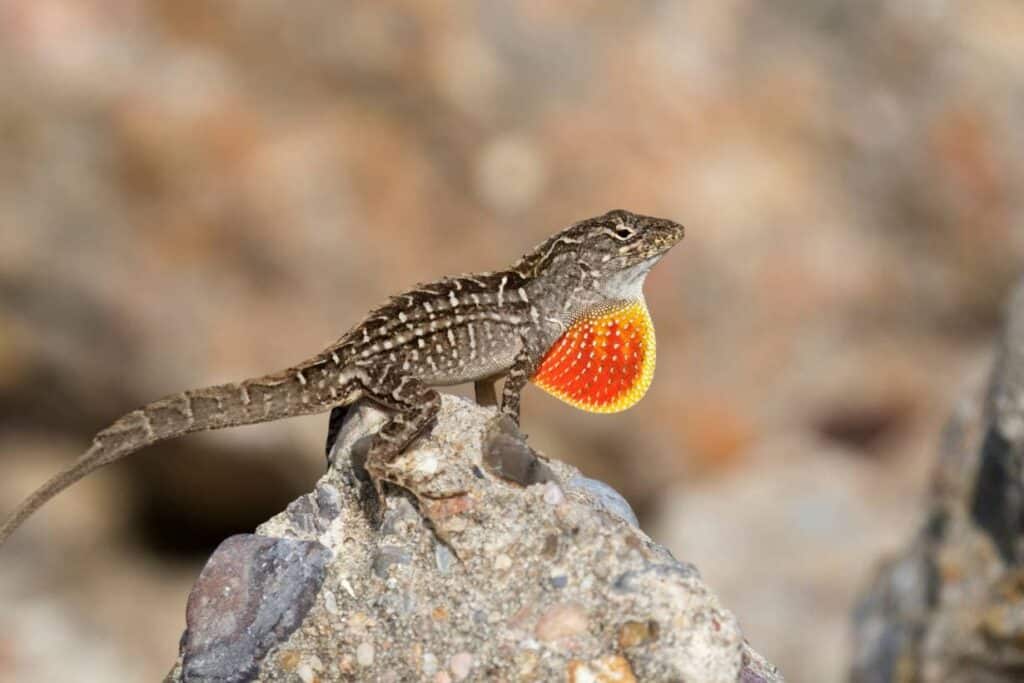
| Species: | A. sagrei |
| Longevity: | 1.5 – 5 years |
| Good to own as a pet?: | Yes |
| Legal to own?: | Yes |
| Adult size: | 9 inches |
| Diet: | Grubs, spiders, fish, other lizards, and lizard eggs |
The Brown Anoles are similar to the Green Anoles, but they hail from Cuba and the Bahamas. They’re small and can be either brown or grey. There is a light yellow or white pattern on their backs. The most noticeable thing about them is their red or orange dewlap. They also don’t have any love for their Anole cousins, eating them and their offspring. Brown Anoles create a reduction in the Green Anole population everywhere that the two species live together.
What to read next: 10 Lizard Species Found in California (With Pictures)

Conclusion
We hope that our list helps you distinguish between lizards if you’re in the Houston area. They can live just fine in urban settings and tend to stick to themselves. Some of them are so good at hiding, you can walk right by and not even notice them. However, no species of lizard on this list will harm a human, so there’s no need to be scared of them if you happen to spot them.
You may also want to read:
Featured Image Credit: Steve Bower, Shutterstock
